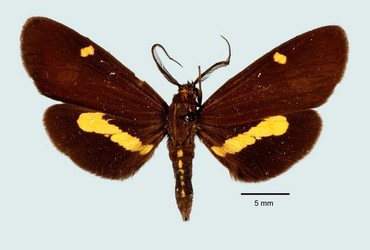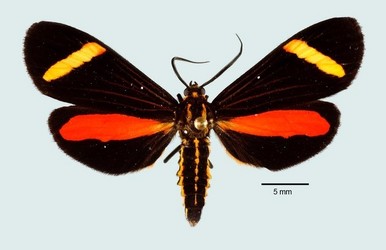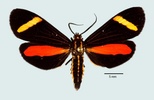Ephialtias
James S. Miller and Andrew V. Z. Brower


This tree diagram shows the relationships between several groups of organisms.
The root of the current tree connects the organisms featured in this tree to their containing group and the rest of the Tree of Life. The basal branching point in the tree represents the ancestor of the other groups in the tree. This ancestor diversified over time into several descendent subgroups, which are represented as internal nodes and terminal taxa to the right.

You can click on the root to travel down the Tree of Life all the way to the root of all Life, and you can click on the names of descendent subgroups to travel up the Tree of Life all the way to individual species.
For more information on ToL tree formatting, please see Interpreting the Tree or Classification. To learn more about phylogenetic trees, please visit our Phylogenetic Biology pages.
close boxIntroduction
A genus of medium-sized neotropical day-flying moths, most with yellow or orange transverse bands on the forewings. Members of Ephiltias are involved in presumed Müllerian mimicry with a variety of other dioptines, arctiids, and other lepidopteran taxa. Recorded larval host plants are Turnera (Turneraceae) and Lindackeria (Achariaceae).
Characteristics
Most species of Ephialtias exhibit a row of yellow or whitish spots on the dorsum of the abdomen, but not all do. Males may be distinguished from similar Getta spp. by the absence of androconial brands on the wings. The most reliable means to verify membership in the genus is by genitalic characters, including elaborate androconial structures on the male valvae (Miller 2009). While hindwing patterns of the abrupta group are variable (the clade is united by genitalic synapomorphies), all three members of the bryce group possess an orange-red radial hindwing band.
Discussion of Phylogenetic Relationships
The structure within the genus is based on the phylogenetic analysis of morphological characters by Miller (2009).References
Miller, JS. 2009. Generic revision of the Dioptinae (Lepidoptera: Noctuoidea: Notodontidae). Bulletin of the American Museum of Natural History 321, 1-971 + 48 plates.
Title Illustrations

| Scientific Name | Ephialtias choba |
|---|---|
| Location | Brazil: Pará, Santarém |
| Reference | Miller JS. 2009. Generic revision of the Dioptinae (Lepidoptera: Noctuoidea: Notodontidae). Bulletin of the American Museum of Natural History 321, 1-971 + 48 plates. |
| Specimen Condition | Dead Specimen |
| Identified By | James S. Miller |
| Sex | Male |
| Life Cycle Stage | adult |
| View | dorsal |
| Collection | CMNH |
| Collector | S. M. Klages |
| Image Use |
 This media file is licensed under the Creative Commons Attribution License - Version 3.0. This media file is licensed under the Creative Commons Attribution License - Version 3.0.
|
| Copyright |
© 2009

|
| Scientific Name | Ephialtias draconis |
|---|---|
| Location | Panama: Canal Zone, Pipeline Road |
| Comments | larva reared on Turnera panamensis |
| Reference | Miller JS. 2009. Generic revision of the Dioptinae (Lepidoptera: Noctuoidea: Notodontidae). Bulletin of the American Museum of Natural History 321, 1-971 + 48 plates. |
| Specimen Condition | Dead Specimen |
| Identified By | James S. Miller |
| Sex | Male |
| Life Cycle Stage | adult |
| View | dorsal |
| Collection | USNM |
| Collector | A. Aiello |
| Image Use |
 This media file is licensed under the Creative Commons Attribution License - Version 3.0. This media file is licensed under the Creative Commons Attribution License - Version 3.0.
|
| Copyright |
© 2009

|
About This Page

Middle Tennessee State University, Murfreesboro, Tennessee, USA
Correspondence regarding this page should be directed to James S. Miller at and Andrew V. Z. Brower at
Page copyright © 2010 and
 Page: Tree of Life
Ephialtias .
Authored by
James S. Miller and Andrew V. Z. Brower.
The TEXT of this page is licensed under the
Creative Commons Attribution-NonCommercial License - Version 3.0. Note that images and other media
featured on this page are each governed by their own license, and they may or may not be available
for reuse. Click on an image or a media link to access the media data window, which provides the
relevant licensing information. For the general terms and conditions of ToL material reuse and
redistribution, please see the Tree of Life Copyright
Policies.
Page: Tree of Life
Ephialtias .
Authored by
James S. Miller and Andrew V. Z. Brower.
The TEXT of this page is licensed under the
Creative Commons Attribution-NonCommercial License - Version 3.0. Note that images and other media
featured on this page are each governed by their own license, and they may or may not be available
for reuse. Click on an image or a media link to access the media data window, which provides the
relevant licensing information. For the general terms and conditions of ToL material reuse and
redistribution, please see the Tree of Life Copyright
Policies.
- First online 10 September 2009
- Content changed 21 July 2010
Citing this page:
Miller, James S. and Andrew V. Z. Brower. 2010. Ephialtias . Version 21 July 2010 (under construction). http://tolweb.org/Ephialtias/138581/2010.07.21 in The Tree of Life Web Project, http://tolweb.org/









 Go to quick links
Go to quick search
Go to navigation for this section of the ToL site
Go to detailed links for the ToL site
Go to quick links
Go to quick search
Go to navigation for this section of the ToL site
Go to detailed links for the ToL site